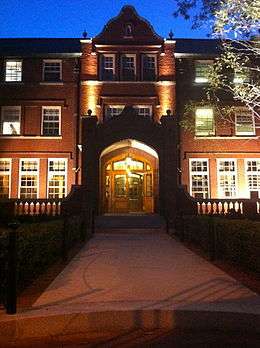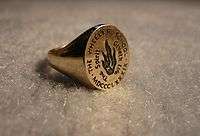Wheeler School
| Wheeler School | |
|---|---|
 The Spirit Giveth Life | |
| Address | |
|
216 Hope Street Providence, Rhode Island 02906 United States | |
| Coordinates | 41°49′44″N 71°23′52″W / 41.828954°N 71.397875°WCoordinates: 41°49′44″N 71°23′52″W / 41.828954°N 71.397875°W |
| Information | |
| Type | Private |
| Established | 1889 |
| CEEB code | 400170 |
| NCES School ID |
Wheeler: 01258081[1] Hamilton: A9300828[2] |
| Head of School | Dan Miller |
| Faculty |
Wheeler: 123[1] Hamilton 16.3[2] |
| Enrollment |
Wheeler: 788[1] Hamilton: 72[2] |
| Student to teacher ratio | 6.2:1 |
| Campus |
Urban, 12 acres (4.9 ha) Farm, 120 acres (49 ha) |
| Color(s) |
Purple Gold |
| Athletics | SENE and Rhode Island Interscholastic League |
| Mascot | The Warrior |
| Accreditation | NAIS[1] |
| Average SAT scores | 680 [Math] 660 [Reading] 690 [Writing] 2030 [Composite][3] |
| Yearbook | Gyre |
| Website |
www |
The Wheeler School is a coeducational independent day school located on the East Side of Providence, Rhode Island, United States. The school serves students from the nursery level through twelfth-grade.[4]
History
Mary C. Wheeler
School founder, Mary Colman Wheeler was born in Concord, Massachusetts, on May 15, 1846. She graduated from Concord High School and Abbot Academy in Andover, Massachusetts. She began her educational career teaching mathematics and Latin in the Concord school system. In 1868, she moved to Providence, Rhode Island to teach at Miss Shaw's, a finishing school for young ladies. In the 1870s, Wheeler twice traveled to Europe to study art and painting and between her trips enrolled in a variety of art history courses taught by Brown University professors. In 1882, she opened an art studio in the Waterman Building on North Main Street in Providence. Two years later she moved into a house and studio she built at 24 Cabot Street and began to offer painting classes for young women three days a week, and for children on Saturdays. In addition she held an evening lecture series on Greek literature and early American history.[4]
In 1887, Wheeler took a group of young women to Giverny, France for a summer of painting, art history and French. These trips were repeated many times through the next two decades and link Wheeler to a number of American Impressionist artists as well as French Impressionist Claude Monet.[4]
Early history
In 1900, adding an academic college preparatory curriculum to her art instruction, Mary Wheeler accepted ten female students as boarders and officially founded The Mary C. Wheeler School. A building on Brook Street was purchased in 1898 to house girls enrolled in the preparatory program for her Cabot Street School.[4]
In 1910, Hope Building was constructed to provide living and dining facilities required by a growing student body and faculty. In 1912 the original Fresh Air Building was completed, though it was later rebuilt. The Mary C. Wheeler School thus became one of the first American schools to use the principles of Dr. Montessori in its kindergarten instruction. Wheeler also purchased the Froebel Kindergarten School and the School admitted boys into its pre-primary grades until the 1950s.[4]
The daughter of a farmer, Wheeler continued on to acquire a 78-acre (32 ha) farm and house in Seekonk, Massachusetts in 1912-13. She subsequently purchased an adjoining farm and buildings, bringing the total land holdings to slightly more than 120 acres (49 ha). At one point, she advertised her school in Vogue as The Mary C. Wheeler Town & Country School.[4]
Mary Helena Dey was hired in 1914 to reorder the school’s curriculum. As a result, the school became a pioneer in the educational theories of John Dewey. Through Dey’s contacts, such notables as Carl Sandburg came to campus to meet with students or in Sandburg’s case, deliver the graduation address.[4]
The first Wheeler Field Day was celebrated in 1915 and is the oldest continuously-celebrated tradition at the School.[4]
Middle years: 1920-1980
Wheeler died in 1920 at the age of 73. In her will she established a Board of Trustees to oversee her school. Mary Helena Dey, who had studied under educational theorist John Dewey at the University of Chicago, was named headmistress. In the mid-20s, the Farm facilities were expanded at a cost of $4,400 to include a field hockey field and two tennis courts. The “swimming hole” was enlarged and deepened. Later an arboretum featuring several hundred unusual plants and trees was established at the Farm in Dey's name, but has been lost to time.[4]
In 1940 Mabel Van Norman was appointed the third headmistress on the retirement of Dey, Van Norman continued the school through the years of World War II and spent time visiting war-torn schools in the Netherlands and Belgium which Wheeler students helped to support with food and supplies. In 1950 she was succeeded by S. Rowland “Rowly” Morgan, Jr. upon her retirement.[4]
Morgan became the first male to lead the School and a Head’s residence was purchased at 211 Hope Street to provide a home outside of the girls' dormitory for his family. In 1952, the Wheeler Annual Fund was established to support the School through donations by alumni, family and friends.[4]
In 1968 Hugh A. Madden was named headmaster on the retirement of Rowly Morgan. Coeducation was approved for the lower grades in 1973 and expanded to include the entire school in 1975. The name of the school officially changed to The Wheeler School. The boarding program phased out in 1979.
Modern-era

William C. Prescott, Jr. succeeded Hugh Madden in 1980.[4]
The Hamilton School at Wheeler opened in 1988 to its first group of 35 students in grades 1-6.[4]
In 1990 a new library was constructed. The building was designed by Schwartz/Silver Architects of Boston. A large division of the Library is named in memory of third headmistress Mabel Van Norman.[4]
Wheeler was the Providence site of the Summerbridge National program in 1992.[4]
WELH- FM (Wheeler's radio station at FM 88.1) went on the air in 1994 at the end of a 10-year process begun as an Aerie student project. At present, it broadcasts Spanish-language programming in the morning and a golden oldies format in the afternoon. The station streams via the internet. Students also use the facilities to record news programs and interviews.[4]
The school today has nearly 800 students[5] with 200 faculty and staff. In addition to its main campus in Providence, the School has a 120-acre (49 ha) Farm facility for athletics, its Sixth Grade Farm Program, summer camp, ropes course, sports programs and environmental research.
Notable alumni
- Devere Allen (1891-1955) - Pacifist journalist and political activist, editor of The World Tomorrow magazine.
- Trudy Coxe (b. 1949) - CEO of the Preservation Society of Newport County and former Environmental Secretary of Massachusetts.
- Nico Muhly (b. 1981) - Contemporary classical music composer.
- Josh Schwartz (b. 1976) - Writer/producer of the television series The O.C., Chuck, Gossip Girl, and Hart of Dixie
- Gloria Vanderbilt (b. 1924) - Heiress
Notes
- 1 2 3 4 "Search for Private Schools – School Detail for Wheeler School". National Center for Education Statistics. Retrieved Oct 22, 2014.
- 1 2 3 "Search for Private Schools – School Detail for Hamilton School At Wheeler". National Center for Education Statistics. Retrieved Oct 22, 2014.
- ↑ https://k12.niche.com/wheeler-school-providence-ri/
- 1 2 3 4 5 6 7 8 9 10 11 12 13 14 15 16 Flynn, Laurie, comp. "History of the School." The Wheeler School. The Wheeler School, n.d. Web. 28 Feb. 2010. <http://www.wheelerschool.org/podium/default.aspx?t=112097&rc=0>.
- ↑ Miller, Dan. "Head of School's Welcome." The Wheeler School. The Wheeler School, n.d. Web. 28 Feb. 2010.